The CM MSG's Development and Divided Thought on How to Defend Taiwan
The development of the CM 105mm MSG illustrates how the Taiwanese military are divided over what equipment is needed to adequately defend the island.

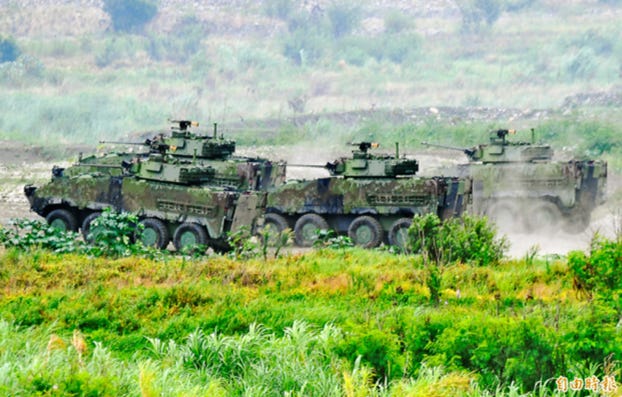
Taiwan announced that the delivery of the final batch of 683 Clouded Leopard Armored Vehicle 雲豹裝甲車—also called the Taiwan Infantry Fighting Vehicle – series will occur by the end of December 2023.
Taiwan announced that the delivery of the final batch of 683 Clouded Leopard Armored Vehicle 雲豹裝甲車—also called the Taiwan Infantry Fighting Vehicle – series will occur by the end of December 2023. The last lot of CM-34 M1 Infantry Fighting Vehicles (IFV) will join a mechanized infantry brigade based in the Huadong region. The Taiwanese military will have 683 total units of the Clouded Leopard series by 2024, with 305 CM-34 M1 IFV and 378 CM-32/CM-33 M1 variants. Taiwan then began development of several specialized versions based on the Clouded Leopard chassis, such as a mortar carrier, 105mm Mobile Support Gun (MSG) and an armored ambulance. However, the 105mm MSG version is the most significant since some officers view the variant as critical to the island’s defense, especially in urban environments. The officers came to this conclusion due to the performance of the CM-11 and M60A3 compared to the CM-32/33/34 IFVs during the 2015 Han Kuang exercise. While the Ministry of National Defense brought the project back due to understanding the need for the platform, the MSG has several issues related to development of its 105mm cannon and height. Other Taiwanese military officers also lacked interest in the MSG due to the viewpoint that the military did not need the platform and the initiation of more favorable armor projects. The CM 1-5mm MSG’s development illustrates the discourse within the Taiwanese military over what equipment the island needs to defend itself from a potential Chinese invasion.


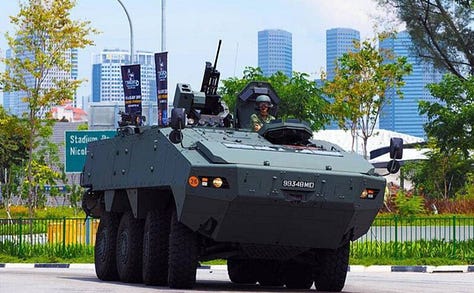



Clouded Leopard Armored Vehicle Series
Taiwan’s Ministry of National Defense began the Clouded Leopard Armored Vehicle program under the Centrino Project 迅馳專案 in 2002. The project’s goal is to create an IFV to replace both the M113 and the CM-21 Armored Personnel Carriers (APC) in service with the Taiwanese military. The Army Ordnance Industry Development Center (AOIDC) 陆军兵工整备发展中心 and Ireland’s Taimoni Technology Company (TTC) began joint development of the vehicle in the early 2000s. Both companies developed a prototype based on the AV-81 APC/IFV developed in 2000 developed by TTC and Singapore’s ST Engineering Land Systems (STELS) for the Singaporean Army. TTC agreed to provide AOIDC with materials and technical support for the center to build the first prototype and to mass produce the vehicles in return for royalties. However, another company that lost the bid to manufacture the IFVs acquired the technologies without paying the royalties by bribing two engineers working on the project. TTC sued AOIDC and other companies for copyright infringement in the mid-2000s and subsequently won the court case. Taiwan produced the CM-32/33/34 Mk1 in a shortened timeframe and developed the follow-on Mk2 to avoid any further legal trouble from TTC/STELS.

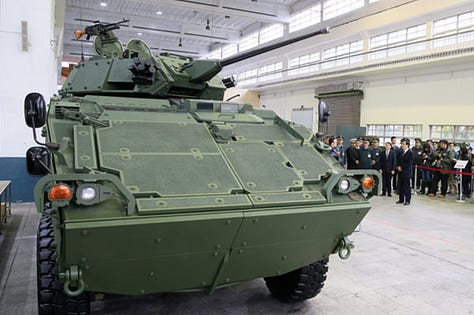



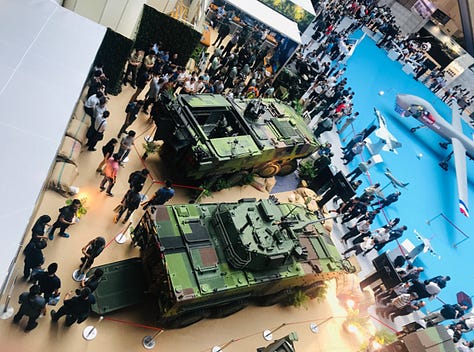
The ministry unveiled the three CM prototypes in a January 2005 military preview in the city of Jili attended by former President Chen Shui-bian. AOIDC began production of the CM-32/CM-33 IFVs in 2007 with production continuing until the center finished production in 2017. Taiwan delayed the production of the CM-34 for approximately 14 years due to issues related to the turret and the autocannon for the IFV. In 2005, the ministry announced that the CM-34 would use a Delco LAV-25 turret armed with a 25mm autocannon and a T74/M240 machine gun. However, the government did not adopt the turret because the turret would cost half the price of the IFV’s chassis. The AOIDC then developed of and conducted trials with a two-man turret armed with a 20mm T75/M39A2 autocannon in 2007. Taiwan planned to use the same APDS ammunition as the Phalanx Block 1B weapon systems to overcome the low penetrating power issues. The center abandoned the 20mm autocannon armed turret by 2010 due to its inability of overcoming the 20mm’s limited penetrating power and the barrel’s short life span.
The bureau then developed a turret armed with 30mm Mk44 Bushmaster II autocannon system by early 2015 with the prototype unveiled during the annual Han Kuang Exercise 2017. The National Chung-Shan Institute of Science and Technology developed a weapon system that modified the cannons to fit with the CM platform. This prototype passed all required evaluations and tests, and AOIDC began mass production of the CM-34 by the end of 2019.
The program created three variants of the Clouded Leopard by the program’s end:
CM-32 Command and Control Vehicle: Tactical Command and Control vehicle a Remote Weapons System (RWS) containing a T91/Mk-19 40mm grenade launcher and T74/M240 machine gun.
CM-33 IFV: IFV armed with the same T91/T74 equipped RWS as the CM-32.
CM-34 IFV: IFV equipped with the 30mm Bushmaster II autocannon, a coaxial T74V machine gun, and a T74/M240 at the commander’s station.
The CM is divided into two upgrades, Mk1 and Mk2, that were the result of improvements made to various aspects of the IFV and to prevent any legal action from occurring.




CM-32/33/34 M1
The CM-32/33/34 M1’s standard armor meets NATO STANAG 4569 Level Three standards and can absorb direct hits from 7.62x51 NATO and equivalent rounds. However, the IFV’s front is comparable to Level Four standards due to the engine and can survive direct hits from .50cal and similar rounds and shell fragments. An armor kit consisting of sandwich-style ceramic plates is available to increase IFV’s overall protection level to Level Four standards. The plates also increase the IFV’s front to Level Five standards or capable of withstanding direct hits from 25mm rounds. The vehicle’s important parts are also covered and lined with Kevlar to protect the crew and equipment from fragments. The transmission and steering system are also stored in the IFV’s underside V-shaped chassis which protects the systems from various landmines. Furthermore, the IFV can withstand the explosion from 26 Ibs (12 kg) of plastic explosives under any of its wheels. The IFV’s rear hatch is opened and closed by a hydraulically controlled hopper door while its roof contains two outward opening hatches on either side of the crew cabin.
The Clouded Leopard uses 8x8 transmission to provide the IFV with improved off-road performance and increase the life span of the tires. The IFV contains an eight-wheel braking system using eight independent sets of disc brake calipers to increase reliability and provide adequate braking power. The CM is the first vehicle in the Taiwanese military to have a digital control system by integrating all the vehicle’s subsystems into one network. The IFV contains two independent and redundant power supply plants that can supply power to weapons and other systems when the engine is off. The plants are located on the right rear side of the vehicles in an anti-electromagnetic interference distribution box that reduces the time required to maintain the systems. The IFV is also the first Taiwanese military vehicle to have an integrated Nuclear, Biological, and Chemical protection/air-conditioning system. The system also integrated an automatic fire detection and extinguishing system to prevent fires from causing ammunition from exploding (or cooking off) in the IFV.



CM M2 Series
AOIDC developed the M2 series in the mid-2010s to improve on the Mk1 and to increase the differences in the vehicle to avoid legal issues related to patent violations. The AOIDC unveiled the M2 prototype for the first time in 2017 at the Taipei Aerospace Exhibition. While the Mk2 is based on the Mk1 vehicle, the Mk2’s armor uses a hollow wedge-shaped armor designed to also withstand Anti-Tank Guided Missiles (ATGMs). The M2’s design separated the chassis and shell into two separate pieces to produce a standardized chassis on the same line and to manufacture different shells based on demand. The design also allows for mechanics to conduct simplified battlefield repair and maintenance on the M2 by quickly swapping out damaged parts on the shells or chassis. Another major difference is the IFV’s redesigned headlights, cameras, and speakers are integrated into the vehicle’s armor instead of attached to it to prevent damage from occurring due to collisions.



The rear hatch’s hydraulically controlled hopper door was changed to a two-door hatch that swings outward to prevent exposing personnel to fragments or rounds when opening or closing the hatch. The designers also changed the roof hatch to a two-sided sliding hatch that will also avoid exposing personnel to the outside environment when opening and closing the door. The M2 will share 70 percent of its parts with the M1 to simplify the vehicle’s maintenance and logistical supply chains when the IFV enters service.

The M2 also used hydraulic shock absorbers with a height control system to improve the IFV’s performance and control vehicle’s weapons recoil. The AOIDC also designed the M2 for a potential amphibious IFV variant by re-trimming the vehicle to allow for the vehicle to float with a high degree of stability. The designers also added two banks of six smoke grenade launchers to either side of the M2’s rear to increase the IFV’s survivability. The designers also changed the steering system from one based on four-wheel system to one based on six-wheel steering. The redesigned system allows for the IFV to reduce the turning radius from 36 ft (11 m) to less than 26 ft (8 m), allowing the IFV to maneuver more effectively in Taiwanese cities. The steering system will also allow the IFVs to move into more advantageous tactical positions when operating in urban environments. The AOIDC designed the M2 to be used as a basis for future variants such as armored ambulances, 81mm/120mm mortar carriers, communications vehicles, and engineering/recovery vehicles.


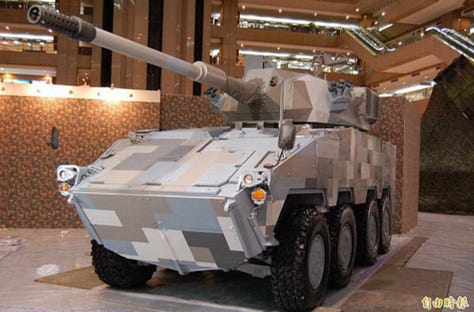





CM 105mm Mobile Support Gun
The development of the Mobile Support Gun (MSG) armed with a 105mm cannon occurred at same time as the CM-32/33/34 prototypes in the early 2000s under Project Cheetah 獵豹專案. Designers based the MSG on the prototype of the CM M1 and used an indigenously developed turret and 105mm cannon. The public unveiling of the MSG prototype occurred at the 2007 Taipei Aerospace Exhibit and military observers and analysts named the vehicle the Black Bear 黑熊. However, The Armored Forces Training Command rejected the vehicle, basing their decision on not having a demand for the MSG in 2007. The command’s officers also rejected the vehicle based on their belief that tanks must have tracks, a heavy turret, and a significant degree of protection and not thin armor or wheels. The generals also worried that the introduction of the Black Bear MSG would negatively affect the planned acquisition of the M1 Abrams Main Battle Tanks (MBT).
However, several Taiwanese military officers determined that the military needs a platform that can provide the firepower of MBTs while having abilty to keep up with the CM-32/33/34s. The officers saw the various limitations the CM-11 and M60A3 MBTs had when operating alongside the CMs during the 2015 Han Kuang Exercise. For example, the MBTs were not as flexible and maneuverable as the CMs while operating in urban areas and faced severe terrain limitations that restricted its ability to operate along the CM IFVs. Without the MBT’s main cannon, the mechanized infantry was limited to the CM-32/33/34’s weapons to provide direct fire support in cities and towns. However, some of the officers remembered the Black Bear prototype and renamed it from wheeled tank 輪型戰車 to 105 mm wheeled combat artillery armored vehicle 105 公厘輪型戰砲甲車. The officers renamed the prototype to avoid labeling the MSG a tank to prevent continued criticism from armor officers. The new name also allowed officers to show it will act as a direct support vehicle for mechanized infantry instead of a replacement of the mechanized infantry brigade’s MBTs. The resignation also served to compare the prototype to similar vehicles as Italy’s 1B Centauro, Japan’s Type 16 Maneuver Combat Vehicle, or China’s ZTL-11.
Senior officials with the National Defense Ministry, specifically the former Defense Minister Yan Tehfa 嚴德發, changed the name back to wheeled tank輪型戰車 from armored artillery vehicle 戰砲甲車. Yan held a different view on the name of armored artillery vehicle and ordered it changed back to wheeled tank. The minister then ordered the transfer of the prototype to the Equipment and Training Department to conduct tests and evaluations. The 2005 prototype’s turret and fire control system performed very well, with all the 105mm cannon passing every test. The AOIDC also built a second prototype with different turret armed with a 105mm. However, the first two prototypes were determined to be higher than any of the combat vehicles in the Taiwanese Army (TA) and did not meet the service’s operational environment. The bureau then developed a third model based on the M2 chassis and body with the aim of reducing the vehicle’s height to the correct requirements.
Regarding the MSG’s 105mm cannon, NCSIST decided to use the M68A2 cannons and brought two from U.S.-based Watervliet Arsenal in 2020. Tests using M426 stabilized discarding sabot armor piercing rounds fire from the cannon showed that the M60A2 cannons are capable of penetrating 500mm of homogeneous armor at 1.25 miles (2 km). The cannon’s recoil force is also approximately 70 percent lower than the M86A1 cannon used on the first prototype. However, NCSIST terminated the contract in 2021 because it could not obtain rights to use the cannon or the export license. The bureau began development of an indigenous version of the M68A1 105mm cannon called the XT112 for use in the second and third prototypes. In 2022, the military announced plans to raise funds to buy 282 CM 105mm armored vehicles, with the TA planned to receive 222 and the Taiwanese Marine Corps (TMC) 60 vehicles. However, development stalled due to the platform’s large size and distance between ground and the gun rail not meeting the TA’s height requirements. The ministry stopped investment in the CM MSG by 2023 due to the beginning of both the M1A2T and M60A3 life extension programs. The bureau also began to modify the third prototype with propellers and increased floating capability to make the vehicle like the ZTL-11 to replace the Taiwanese Marine Corps M60A3 fleet.
Analysis: The CM Clouded Leopard series shows that Taiwan’s defense industry can produce IFVs in significant quantities to equip its military. For example, the AOIDC produced and delivered the 683 IFVs to all the TA mechanized infantry brigades as outlined in the contract. Furthermore, the CM also incorporated new technologies developed by the AOIDC such as an integrated NBC system and fire extinguishing system. The CM-32/33’s RWS is also significant since it is the first one of its kind that Taiwan indigenously developed for its military. However, the IFV’s development also showed the industry still has deficiencies it would need to overcome. The CM-34’s use of imported Bushmaster Mk44 barrels and feeding mechanism illustrates how the industry is still unable to indigenously produce high quality autocannons similar to the United States. Another example is the early versions of the RWS crashing due to overheating caused by the station’s slow heat dissipation.
The development of the CM 105mm MSG over the last 15 years illustrates the divide that exists between senior Taiwanese officers over how to best defend Taiwan. The AOIDC originally developed the Black Bear MSG due to the Taiwanese military potentially requiring the vehicle. However, senior military officers rejected the MSG in 2007 because they saw no operational need or requirement for the vehicle. Furthermore, the officers also feared that the MSG would supplement and take over the M60A3’s and M1A2T’s traditional anti-armor role at the mechanized infantry brigades. This thinking is reflected in how the armor officers believed that any vehicle using the word ‘tank’ should fit the exact definition such as using tracks, a massive turret, and heavy armor. Some officers only realized they needed a platform capable of providing direct fire support to mechanized infantry while capable of operating with the CM-32/33/34s in cities and restricted terrain. The realization occurred due to observing the CM-11 and M60A3’s inability to support and accompany the CM-32/33/34s in cities during the 2015 Han Kuang exercise. The renewed requirement for a direct fire support vehicle revived interest in the CM MSG.
However, the renewed CM 105mm project faced the same obstacles such as some senior officers still do not see the need for a MSG because MBTs could fulfill the same role. This belief is reinforced by the introduction of the M1A2Ts and the extension of the M60A3s within the next couple of years. Specifically, the officers believe that there is no need for it since they would have two MBTs that would provide the same level of support to infantry in urban terrain. The M1A2Ts would likely be unable to fulfill the role since they would be defending key areas on the island, such as the cities of Taipei and Kaohsiung. The M60A3s also proved to have difficulty in supporting the CM-32/33/34s and mechanized infantry in cities due to the lack of mobility and inability to travel with the IFVs. The M1A2Ts would also face significantly worse mobility issues than the M60s due to M1A2T’s increased weight and length.
The CM 105mm also shows how senior Taiwanese officers still hold the belief that the military need ‘big ticket items’ such as the M1A2Ts or the Hai Kun-class submarines to defend the island. These officers do not want to come to terms that they will be fighting a defensive war when China invades and need equipment that is survivable from air or missile strikes. Furthermore, the equipment will place severe restrictions on the Taiwanese ability to fully utilize it. For example, the M1A2Ts would be limited to only a few areas along the island’s western coast and would face severe mobility issues when moving to areas or locations where they are needed. The MBTs would also face logistical constraints such as limited fuel or spare parts due to airstrikes destroying or disrupting logistical lines. However, the mindset would likely be tempered with the realization that the Taiwanese military requires equipment that fits more of its current defense outlook rather than its wishlist.



